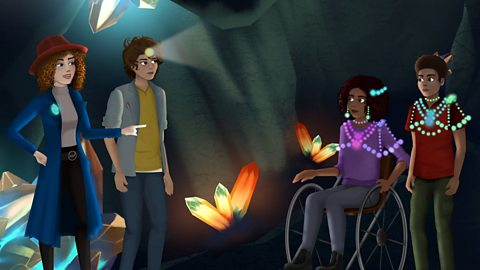NARRATION:Back in the deepest, darkest depths of time, there lived a great mathemagician called Hypatia. Numbers fell under her spell one by one. With them, Hypatia could do anything. Now Hypatia is looking for people to share her powers with. She has forged a mathematical maze. Only true mathemagicians can solve the puzzles and find their way out. Join two young explorers, Oliviaand Hassan, to solve the puzzles, escape the maze and become the greatest mathemagicians of all time.
Mental multiplication.
HASSAN:Arghhh! Snake!
OLIVIA:That's a twig, Hassan.
HASSAN:I knew that yeah, like this twig.
OLIVIA:That's a snake.
HASSAN:Argh!
OLIVIA:That was a close one.
HASSAN:Too right. Do you think we're nearly there?
OLIVIA:Well, Archimedes said follow your nose and, oh, it's getting pretty stinky around here.
HASSAN:Yep.
OLIVIA:There! The compass will help us find the exit portal. Oh, it's stuck.
HYPATIA:You can try as hard as you like, it won't come loose. If you want the compass, answer this. What is a square number?
HASSAN:A square number, what does she mean?
OLIVIA:Maybe four? That has pretty square sides.
HASSAN:Or one, that's gotta be quite straight sides.
OLIVIA:Hmm, I'd call that more of a line.
HASSAN:Fair.
HYPATIA:One more hint I'll provide, to make a square number, two numbers must align.
HASSAN:Two numbers must align.
ARCHIMEDES:Phew, sorry I'm late. I got stuck in a number bog back there.
OLIVIA:Archimedes! We're looking for a square number. Have you seen one?
ARCHIMEDES:Let me help you.
HYPATIA:Arrange these beetles with care and you will learn the secrets of squares.
HASSAN:Okay, here are 36 beetles, now what?
OLIVIA:Two lines of 18. Two 18s make 36. Three 12s make 36.
HASSAN:Four nines are 36. I feel like the beetles are trying to tell us something Six sixes are 36.
OLIVIA:Yeah, they seem quite It's a square, look! Six is a square number.
ARCHIMEDES:Not quite.
OLIVIA:Oh, 36 is the square number. 36!
HYPATIA:Well done.
HASSAN:Why didn't the portal open?
HYPATIA:My maze has many ways, one false move and you've lost your groove. Back you'll fly, ten handles again you must try.
OLIVIA:Do you get what she's on about?
HASSAN:Pick the wrong portal and we'll be ten steps back.
OLIVIA:Oh. That would be rubbish.
HYPATIA:The compass is a key to many locks. The square number leads to the right portal.
HASSAN:The sides of a square are always the same length.
ARCHIMEDES:So we need to find a number that can be made by multiplying the same two numbers together.
OLIVIA:Let's run through them. Yo, bugs! One times one
HASSAN:One. Two times two
OLIVIA:Four. Three times three
HASSAN:Nine. Nine is the square number!
HYPATIA:Well done.
OLIVIA:Let's do this! Bye Hypatia!
HYPATIA:I have a question for you, my young mathemagicians. Is it always, sometimes, or never true that square numbers have an even number of factors?
Video summary
While exploring a jungle, Olivia and Hassan learn the true nature of square numbers as being created when two of the same number are multiplied together.
Baffled at the thought of a square number, Oliva and Hassan start by mistakenly looking for numbers which look like squares.
With the direction of Archimedes however, they learn the true nature of square numbers as being created when two of the same number are multiplied together.
This short animated film is from the ┤¾¤¾┤½├¢ Teach series, Hypatia's Mathematical Maze.
Teacher Notes
Before watching the film:
Prior to this lesson you may wish to introduce students to other relevant topics, for example:
- Repeated addition as multiplication
- Times tables up to 12
- Multiplication and division represented by arrays
During watching the film:
Depending on the focus of the lesson, you might wish to pause the film in certain areas to check for understanding, asking questions such as:
- What other square numbers are there?
- How would you define a factor?
- How would you define a prime number?
- Is 1 a prime number?
- Can you answer HypatiaÔÇÖs final question?
Final question:Is it always, sometimes or never true, that square numbers have an even number of factors?
Answer to the final question:Square numbers never have an even number of factors! All the factors have a pair except a square, because its pair is itself. Take a look at square number 16. It has one less factor than 18, which is not a square number.
Following on from the film:
- Make square numbers by using counters and then explore the other factors these square numbers have. Explore the meaning of square. Remember, the square cannot have a hole in the middle.
- Explore the patterns made by the different times tables by colouring them in on a hundred square. The 5 times table is just two columns of coloured-in numbers. Why is that? The 9 times table is a diagonal line going backwards. Why is that pattern made? Which times tablesÔÇÖ patterns are similar and why?
This short film is suitable for teaching maths at KS2 in England, Wales and Northern Ireland and 2nd Level in Scotland.
Adding and subtracting using mental methods. video
In a mythical temple full of obstacles, Olivia and Hassan learn simple mental maths and apply it to work out the passcode to open the door.
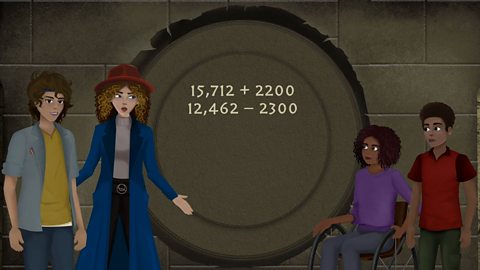
Adding and subtracting using written methods. video
Having been transported to a floating library, Olivia and Hassan's ability to solve large equations using written methods is tested.
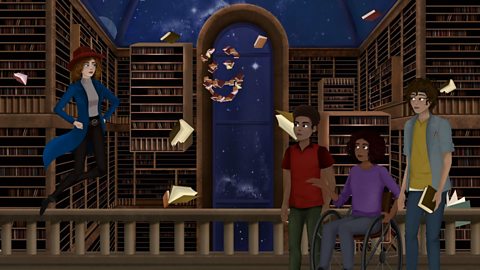
How and why we round numbers. video
Olivia and Hassan are taught how to round to the nearest 1000, 10,000, and 100,000 when a disgruntled magic carpet demands money from them.

Using addition and subtraction in multi-step problems. video
Inside a giant computer created before the age of mathemagicians, Olivia and Hassan are faced with a multi-step problem to reach the labyrinthÔÇÖs next stage.
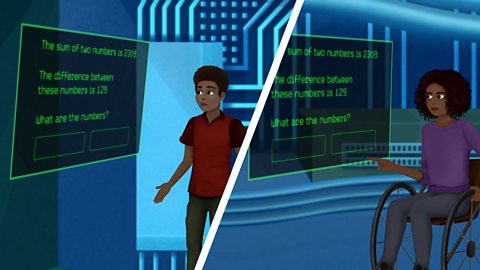
Multiplying by 10, 100 and 1000. video
When Olivia and Hassan find themselves on the roof of an enormous skyscraper they learn how to multiply by 10, 100 and 1000 and work out the number of windows on the building.
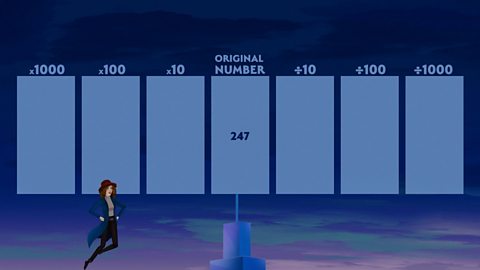
Factors, multiples and primes. video
Trapped in a desert together with Archimedes, Olivia and Hassan learn what common factors, multiples, and prime numbers are.
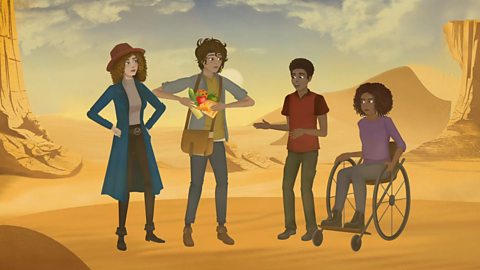
Multiplying using written methods. video
Finding themselves in space, Olivia and Hassan watch mathemagician Hypatia perform long multiplications in the sky by bending the stars.
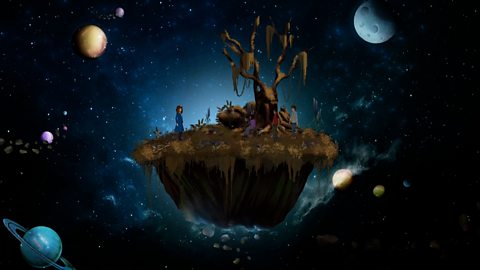
Dividing using written methods. video
Olivia and Hassan learn how to perform long division in order to free gridlocked traffic on a bridge.

Recognising and comparing fractions. video
Olivia and Hassan are enjoying themselves in a world made out of pizza and learn how to work with numerators and denominators in fractions.
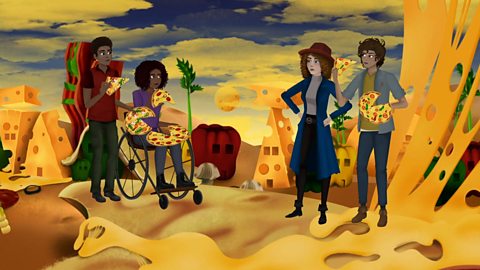
Adding and subtracting fractions. video
Amongst the ruins of an ancient city, Olivia and Hassan learn how to add and subtract fractions.
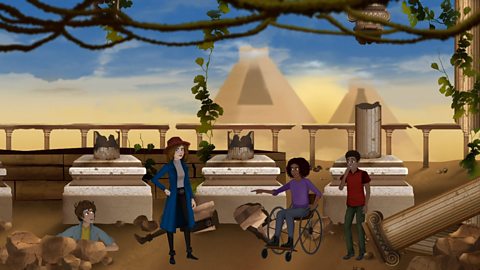
Multiplying and dividing fractions. video
In a mysterious crystal cave, Olivia and Hassan get to work dividing and multiplying fractions in order to find their way out.
